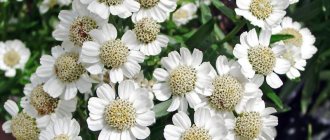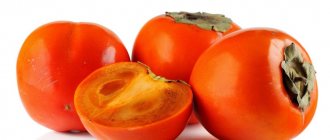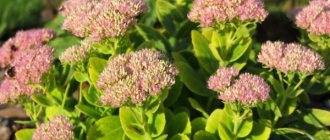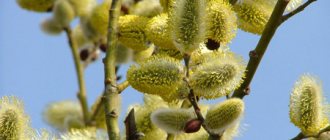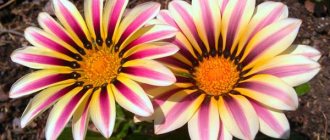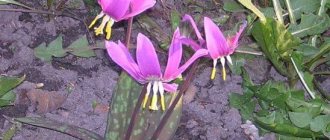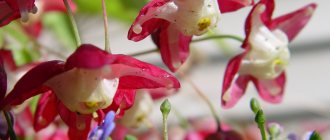2.Description - what the flower looks like
Bathing or frying, field rose, May rose, trollius, kupavka - all these are names of the same herbaceous plant. The genus includes about 30 flower species.
The rhizomes of the plant are fibrous, with a large number of brownish cord-like shoots. This perennial has thick, erect stems that are abundantly branched at the base.
↑ Up,
Openwork, deeply cut leaves are arranged alternately. The leaf blades are dark green, with large teeth along the edges. Depending on the height at which the leaves are located, their appearance changes. If at the base of the plant large, often complex leaves on long petioles form, then higher up on the shoots simple, sessile leaf blades of smaller size appear.
The flowers are solitary, cup-shaped, very attractive, white, yellow or orange, with rounded petals. In the center of the buds there are numerous stamens. In some species, the flowers emit a pleasant aroma, while in others they remain half-open.
After flowering, seed pods—leaflets—appear.
↑ Up,
Height . Depending on the type, the height of the swimsuit can range from 10 cm to 80 cm.
Comments (2)
Natasha
04/13/2019 at 14:32 |
A very beautiful plant, looks elegant and delicate. Please tell me, given that it is not ours, will it grow in our colder and more severe climatic conditions, or not?Answer
Yulia Expert Plodogorod
04/13/2019 at 17:07 |
Hello, Natasha! This is a rather unpretentious plant; it does not make any special demands on the soil or conditions. But, if there is such an opportunity, then it is better to prefer a shady area to a sunny one.
If there is a lot of sunny color in the area where the flower grows, then both the bushes and the buds will be small and not very decorative.
Before planting, it is better to make the soil loose and provide drainage. The plant does not tolerate stagnant moisture at the rhizome. There is no need to worry about fertility. This flower will not grow except in very dry and sandy soil. Moist loams are best suited.
The most important requirement is sufficient watering. It is a good idea to add peat and rotted humus to the soil before planting. As a fertilizer, nitrophoska produces a good effect. You can also buy fertilizer for flowering plants. A suitable option would be an Azalea mixture.
The optimal time for planting is mid-summer.
Further care mainly consists of watering, which can be combined with the application of fertilizers, for example, urea. You can also use the drug Agricola. The most important thing is to feed the bushes before flowering begins. Then decorativeness and an abundance of buds are guaranteed.
You can also carry out the fertilization procedure in mid-spring to improve the set of green mass.
Regarding the issue of cold and harsh climate conditions, there is no need to worry. This is a cold-resistant plant that does not even require shelter during the winter.
But, if winter-hardy plants have frozen out in your area, then you can use agrofibre. This plant can be found in almost all climatic zones.
Answer
4.Types of swimsuit:
4.1.European or common swimmer - Trollius europaeus
Another name for this species - “italmas” - comes from the Udmurt language. Large herbaceous perennials 45–60 cm high. The flowers are yellow, half-open, reaching a diameter of 5 cm. The leaves are green, deeply dissected, and consist of 3–5 large-toothed segments. Flowering occurs in late May - early June.
↑ Up,
4.2.Asian swimsuit or Asian fireweed - Trollius asiaticus
Squat, stocky plants up to 45 cm high with green, glossy leaves and large, single flowers up to 4.5 cm in diameter. Found on the Eurasian continent, in fields and forest edges.
↑ Up,
4.3.Chinese swimsuit - Trollius chinensis
Based on this species growing in its natural habitat in China, several cultivars and hybrids have been bred. It is a flowering perennial 45 - 60 cm high with fairly thin, erect stems. The leaves are dark green, dissected. The peduncles are thin, tall, and bear single bright flowers at the tops with a diameter of up to 5 - 7 cm.
↑ Up,
4.4. Tallest swimsuit - Trollius altissimus
The species is distributed in Central and Eastern Europe, Scandinavia and England. This perennial, depending on external conditions, reaches a height of 20 - 100 cm. The flowers of these plants are half-open, cup-shaped, with rounded lemon-yellow petals. The outer petals are colored greenish.
↑ Up,
4.5. Altai swimsuit - Trollius altaicus
This species grows in Altai, Kazakhstan, Siberia and Mongolia. It is a perennial plant that blooms in May - July. The bushes reach a height of 50 cm.
↑ Up,
4.6. Ledebour's swimsuit - Trollius ledebourii
Flowering bushes grow up to 60 - 90 cm and are found in nature in Mongolia, Russia and Korea. The plants are characterized by rather late flowering - the first buds bloom in June, and the last ones can open at the end of May.
↑ Up,
4.7. Narrow-petaled swimsuit - Trollius stenopetalus
Compact appearance - bushes often grow up to only 40 cm in height. Flowering occurs in May - June, and a second wave is often observed in early autumn. The buds are large, reaching 5 - 7 cm in diameter, the oblong petals of the flowers can be colored yellow or purple.
↑ Up,
4.8. Yunnan swimsuit - Trollius yunnanensis
Plants are of medium height - reach 40 - 50 cm, have glossy green leaves. The flowering period occurs in late spring - early summer. One of the few types of swimsuit that can be used for cutting. In a vase with water it does not lose its attractiveness for up to 5 - 7 days.
↑ Up,
4.9.Rider's swimsuit - Trollius riederianus
Delicate plants with lacy foliage, often filling large spaces on hillsides. Leaf blades, consisting of 3 - 5 segments along the edge, have small denticles. The flowers are solitary, golden-yellow. The plants reach a height of 60 cm and are found in the Far East, Japan, Korea and Kamchatka. Flowering is very late - occurs in July - August.
↑ Up,
Landing place
Although in nature the crop grows in both sunny and shaded areas, in order to obtain large flowers, in the garden or front garden the plant is placed in the shade on well-moistened but not flooded soil.
Siberian rose prefers medium loamy soil. To better retain moisture in the ground during planting, you can add a mixture of peat and humus at the rate of 5 kg per 1 sq.m. But you need to make sure that the water does not stagnate in the area.
Don't miss: Photos of beautiful varietal peonies
5.Varieties and hybrids of swimsuits:
5.1. Golden Queen swimsuit - Trollius chinensis Golden Queen
A distinctive feature of this variety, bred on the basis of the Chinese swimsuit, is the presence of large, orange flowers with a diameter of up to 6 - 7 cm with numerous fluffy stamens in the center of the buds.
↑ Up,
5.2. Bathing suit Alabaster - Trollius cultorum Alabaster
Hybrid plants up to 60 - 70 cm high with unusual light, almost white buds. Flowering occurs in late May - early June. The flowers last a long time when cut.
↑ Up,
5.3. Lemon Queen - Lemon Queen
Flowering perennials 55 - 60 cm high with delicate, half-opened buds with double rows of light yellow petals. The leaves are openwork, green, with a glossy surface.
↑ Up,
Perennial bathing suit. How to grow and care: tips with photos
There are many bright and extraordinary flowers in the Ranunculaceae family, to which the word “ordinary” certainly cannot be applied. The Latin name of the swimsuit Trollblume is translated as “troll flower”, trollius. Which already speaks about the unusual origin of the plant. According to another version, troll is the ancient German word for “ball”. It also seems plausible, especially if you carefully examine the bush itself. Well, the Russian name “swimming flower” is inextricably linked with the places where the culture grows. These are wet, swampy areas. About 30 species of Trollblume are known.
Detailed description of culture
It’s hard to believe, but the flower stalks of the swimsuit take two whole years to form! First, a root rosette is formed. A year later, a shoot appears with leaves at the top and a flower. The plates are lobed and palmate. Shoots with flowers also grow from some axils. But the closer to the side buds, the smaller they are.
Swimsuit
- The flower is spherical in shape and can be open or semi-open. Consists of a perianth in the form of a corolla and sepals. There can be either five or twenty. The color is deep orange, transitional from green to orange.
- The plant has, although not strong, a very pleasant aroma. It attracts bees, bumblebees and other insects, so there are no issues with pollination.
- The fruit is a leaflet. The seeds are oval, black, glossy.
- Reaches 100 centimeters. Flowering occurs in late spring or early summer. Duration – 30 days. In Russia and the CIS countries, the swimsuit plant is represented by 20 species.
- The answer to the question of where the swimsuit grows is obvious. It is distributed throughout the globe. The most varieties of trollius are found in North America, Eurasia, and East Asia. In some states it is even listed in the Red Book.
- Toxicity is another important feature of the culture. Planting work is carried out wearing protective gloves.
Types, varieties
For a plant such as the swimsuit, the description would be incomplete without considering the main species suitable for ornamental cultivation.
Swimsuit bush
The most common flowers in our gardens are the European and Asian kupava flowers. They bloom at the end of May, Chinese swimsuit - in June. Without a doubt, we are talking about the most prominent representatives of culture. The flowers are not just big - they are huge, reaching 6 cm in diameter, and colored orange-red. There are so many nectary petals that the flowers seem double. By the way, they bloom longer than other species - two whole months instead of one. The Etna and Chinese swimsuits are very similar.
Among the short ones, the dwarf one is common, reaching only 15-20 cm. It resembles a buttercup, the flower size is no more than 3 cm. You can recognize the Altai species by the dark spot inside each flower. Flowering begins in June, but it is very short-lived.
Photo of a swimsuit
Which variety is considered optimal for growing at home? For residents of the northern regions, the Siberian swimsuit is suitable; gardeners in central Russia, Ukraine, and CIS countries should pay attention to the type of cultural swimsuit. It brings together dozens of varieties. Unlike natural plants, varietal ones have larger flowers and richer colors.
“Elist of All” is considered the earliest - yellow flowers bloom in early May. Late garden forms include the cultural Golden Queen (June-July). Then you can choose by color:
- Orange: Goliath, Orange King and cultural swimsuit Orange Princess.
- Yellow: Lemon Queen, Canary Bed.
- Light cream: Cheddar, Alabaster.
Planting in open ground
Using the Golden Queen as an example, let’s look at growing and caring for the cultural leotard in a flowerbed or garden plot. The easiest way is to go to the store and buy ready-made seedlings. It does not require any special gardening skills.
Note! The main condition for normal growth is constantly moist soil. If it is not observed, at the first drought the garden bathing suit will die.
Search for a place
If your flower bed has an area with indirect light, this is an ideal place to plant trollius. For example, next to a stone hill, tall ornamental bushes. The main thing is to avoid prolonged exposure to direct rays. The option of open disembarkation is also allowed. However, flowering will be short-lived and the buds will be small.
Are there any specific requirements for the composition? Fortunately, no. It has been noticed that swimsuit grows best on medium loamy soil without stagnant water. If desired, you can add a little humus or nitrophoska (10 g) to the hole.
- For a swimsuit, the time of planting and further care in the open ground goes beyond the generally accepted framework. Planting is carried out at the end of summer. Not in September, but in August, so that the plant has time to get stronger for winter.
- Regardless of the chosen variety, all specimens reach the size of a small bush and branch well. The recommended distance between them is 50 centimeters. The root collar goes deep into the soil by about 2 centimeters. For successful rooting, leaves are trimmed. New ones should appear within 14 days.
Advice! The crop does not need replanting and can grow in one place for up to 10 years.
What should care be like?
In general, the care requirements are standard: water, feed, remove dry shoots on time. If you follow the basic rules, the trollius grows and will delight you with double flowering. And the open swimsuit is not afraid of frost, so you don’t have to cover it for the winter.
- Watering. Frequent, no frills. The ideal situation is when the “troll flower” is in moist soil, but excess water does not stagnate. Both underwatering and overwatering are destructive. Proper watering is especially important when young bushes grow in the flowerbed.
Orange swimsuit flower
Diseases, pests
The plant is resistant to various diseases and pests. Occasionally it is affected by a fungal infection, and septoria or smut may appear. The affected parts are cut off. However, in most cases, you have to dig up the entire plant, and spray the soil and neighboring flowers with a fungicide. It is better to immediately determine the cause of infection and prevent the occurrence of diseases in the future.
Application in design
Swimsuit is a flower that is wildly popular when decorating summer cottages. The European (ordinary) swimsuit is the most decorative, but other varieties are no less interesting. It harmoniously complements almost any flower stalks and shrubs, as it has a laconic shape.
Swimsuit in the field
- It is used to dilute herbaceous plantings. The composition becomes tender and pretty.
- Used as an addition to rock gardens.
- Combine with dark blue catchments.
The best neighbors of trollius are delphinium, columbine and cornflower. The combination of yellow and purple looks very organic. Low-growing species are planted in the foreground: sleep grass, clover.
Note! When decorating a garden slide and stones, the swimsuit occupies the space in the middle. Low-growing perennials are planted in front, and tall bells and cornflowers in the back. The timing of flowering of plants is selected so that the area is fragrant all summer long.
How to replace a flower if it is not possible to grow a swimsuit due to climate or other reasons? You can plant other plants belonging to Buttercups on the site. For example, clematis and coppice.
Application in medicine
Despite its toxicity, kupavka has medicinal properties and helps in the fight against illnesses. Tinctures and decoctions are made from the roots, leaves and flowers. The tincture is used to treat dropsy, scurvy, and is used in the treatment of scabies. A decoction prepared from the leaves is indicated for gastrointestinal diseases.
Ointments for external use heal wounds and abscesses. Despite a number of beneficial properties, before using medicines and decoctions based on the bathing suit, you should consult a doctor. The plant is poisonous and, if dosed incorrectly, can harm the digestive and nervous systems.
conclusions
The perennial bush shrub belongs to the Ranunculaceae family. It is popularly called Siberian rose, kupavka and trollius. Scandinavian peoples believed that unusually bright flowers were favorites of trolls. The herbaceous perennial is easy to grow in a flower bed. The area is instantly transformed; you can combine Trollblume with many other plants. Thanks to this article, you learned how to grow a crop, learned what a flower looks like and how to properly care for it. We hope the information was useful and valuable!
6. Planting and care
All work with the plant should be carried out with protective gloves - the flower is poisonous. To grow the swimsuit, select a well-lit or lightly shaded area. If a flower grows in nature in partial shade, then varieties bred on the basis of this species will have good shade tolerance.
For flowers whose habitat includes mountain slopes or lawns, only a sunny place is suitable - in partial shade their flowering will become weak, and the plants themselves will become loose and elongated. With prolonged exposure to sunlight during the daytime, flowering may be shortened, and the buds will lose their attractiveness faster.
↑ Up,
The height of bushes grown in the shade can be 20% higher than the height of the same plant in open sunny space. With a lack of light, plant development will become slower, and the buds will become shredded and pale.
Some varieties may require wetlands or areas located in close proximity to bodies of water.
↑ Up,
6.1.When and how to plant
Seedlings are planted in open ground at the end of summer, trying to delay planting until the onset of rainy and cloudy weather. When planted in the daytime, under the scorching rays of the sun, the plants may suffer for a long time.
Spring planting will inevitably have a negative impact on flowering and the plants will become weak. Planting at a later date will threaten the flower with death - it simply will not have time to adapt to the new place and form roots before the onset of frost.
↑ Up,
The swimsuit reacts negatively to transplantation, so she should immediately find a permanent place. Kupavka does not like flooded lowlands and places where moisture is retained in the soil.
A day before planting, seedlings in pots are thoroughly watered until the soil is completely wet. The earth is thoroughly loosened and weeds are removed, also removing roots.
↑ Up,
Dig planting holes, the depth and width of which slightly exceeds the root ball of the seedlings. The distance between the holes will depend on the planting pattern and the height of the bushes - for miniature varieties whose height does not exceed 10 cm, it is enough to leave 7 - 12 cm. For tall plants, whose height can reach 80 cm, leave 60 - 70 cm between the holes.
The seedlings are removed from the pots together with the root ball and placed in the holes without destroying it. When planting, you should make sure that the root collar of the plant is 2 - 3 cm below the soil surface.
↑ Up,
Part of the leaves or even all the foliage should be cut off when planting. Such a measure will help the plants retain moisture in the roots, and new leaves will decorate such specimens after 2 - 3 weeks.
The bushes are sprinkled with earth in a circle and tamped lightly. The seedlings are watered abundantly with rain or well-settled tap water.
After planting, it is worth organizing a layer of mulch 4-5 cm high around the flower. The mulch can consist of pieces of bark, burnt sawdust, it will retard the growth of weeds and the evaporation of moisture from the soil surface.
In the first 2 - 3 weeks, the plant should be protected from direct sun.
↑ Up,
6.2.Soil for a swimsuit
The flower prefers light and nutritious soils based on leaf turf humus, with a large amount of nutrients.
In order to improve the structure of heavy loams, river sand is mixed into them - it prevents the soil from caking and allows it to more easily pass moisture.
The swimsuit does not like very acidic soils - slaked lime, crushed chalk are first mixed into the soil, or the pH level is adjusted using crushed eggshells. Plants respond well to the addition of pieces of charcoal or wood ash.
↑ Up,
6.3.Water and fertilize
Immediately after planting and during the first month, watering should be regular - if the soil is too dry, the bushes may not take root. The soil is kept evenly moist by watering in the morning and evening.
Always water the plants abundantly, trying to prevent moisture from getting on the flowers and buds. You should not water the trollius during the day - the sun's rays passing through droplets of water onto the leaves can leave burns.
Adult flowers often tolerate slight drought, so they can be watered less frequently - for example, every week. Overdrying the soil can lead to the death of the flower.
↑ Up,
After watering, the soil around the flower is carefully loosened to a depth of 2 - 3 cm, trying not to touch the surface root system, and the area is weeded.
Swimsuits react positively to both mineral and organic fertilizers. Well-rotted manure, leaf and turf humus can be used as organic matter.
Nitrogen-rich compounds are sometimes used as mineral fertilizers - I use them in early spring and when growing young plants. Nitrogen helps plants develop green mass faster.
↑ Up,
For abundant and long-lasting flowering, plants will need different compositions - with a high content of phosphorus and potassium.
The first fertilizing is carried out in early spring, often simply by scattering nitrogen fertilizers over the surface of the snow. As soon as the buds are formed, potash and phosphorus fertilizers are applied.
After flowering, the plants are fed one last time before the onset of winter - during this period it is better to provide the flowers with a sufficient amount of potassium or feed them with ordinary wood ash.
↑ Up,
6.4.Pruning, shelter
Timely removal of fading buds will save the energy of plants that will not need to form seeds. With this pruning, you can reduce the appearance of single buds in the second half of summer or the second wave of flowering in late summer - early autumn.
In mid-autumn, as they die, the leaf blades are cut off at the base. Before the onset of night frosts, the entire above-ground part of the plants is cut off, leaving only 2 - 3 cm of shoot height.
↑ Up,
When grown in the middle zone, the swimsuit does not need additional shelter. Some species calmly tolerate frost down to -20 degrees, while others do not die even at -35 degrees.
In more northern regions with little snow and harsh winters, the flower is spud high and sprinkled with dry leaf litter or covered with spruce branches.
Remove the shelter immediately after the snow melts in this place. Autumn pruning will prevent the occurrence and spread of fungal diseases, which often occur on rotten leaves.
↑ Up,
6.5.Transplantation - when and how to seat the swimsuit
In the same place, a swimsuit can easily grow for 8 - 10 years. Mature plants bloom profusely and for a long time. Trollius has a negative attitude towards frequent transplants, so they should be carried out only when necessary.
If there is no need to propagate and divide the bush, then the flower is moved by transshipment - dug up along with a lump of earth, placed on a piece of polyethylene. Such a bush is transferred to a new place and planted without destroying the earthen ball.
↑ Up,
With age, plants often become large and can be transplanted to a new location by dividing them into several parts. When replanting, they try to minimally disturb the root system, and the transplanted plants are protected from direct sun immediately after planting and ensure that the soil always remains moist.
Flowering bushes should not be moved - it is better to replant after complete flowering - at the end of August - the first half of September.
In the second year after transplantation, flower buds will be weak, if they appear at all. The onset of abundant flowering can only be expected in the third year after transplantation.
↑ Up,
Planting a swimsuit in open ground
When to plant
If you are going to grow swimsuit from seeds, you should know that the seed material of this plant needs to be pre-treated at low temperatures. You can sow swimsuit seeds in late autumn in a container and keep it in an unheated room, where the seeds will undergo natural stratification during the winter months and germinate in the spring. But it is better to put the seed after harvesting in a bag with damp sand, place it in the vegetable drawer of the refrigerator and keep it there for 3-4 months at a temperature of 2-4 ºC, and in March sow the seeds in the substrate and wait for germination at a temperature of 20 ºC.
- Growing seedlings without using soil
In the photo: Blooming swimsuit in the garden
Swimsuit seeds germinate very slowly, but by mid-April or May, seedlings will probably appear. It is imperative to protect the seedlings from direct sunlight and prevent the substrate from drying out. At the stage of development of the second true leaf, the seedlings dive, keeping a step of 8-10 cm, and in August the seedlings are planted in open ground.
How to plant
In the wild, the swimsuit grows in both sun and partial shade, but in cultivation it is advisable to grow it in well-lit places, away from the shade of trees and shrubs. The best soil for the plant is structural medium loamy or light loamy soils with a high humus content. The soil should be rich, light, and its pH should be close to neutral. The swimsuit flower can also grow on poor soils if peat mixed with humus is added to it, which will absorb moisture and retain it in the soil. Consumption of peat-humus mixture – 5 kg per m².
The seedlings, together with a lump of earth, are planted in holes located at a distance of 30-40 cm from each other. The swimsuit plant does not like transplants, and can grow in one place for 10 years. Seed-grown swimsuit blooms in the third or fourth year.
7. Reproduction
Reproduction is possible in several ways at once - you can get new plants by division, grow from seeds or cuttings.
7.1.Growing from seeds
When growing from seeds, you should be patient - in the first year after sowing, the plants will form only a basal rosette of leaves, but the buds will decorate such bushes only in the second year of life.
Species plants can be propagated using their own seeds - they are collected in the fall from fully ripened seed pods. It is better to postpone seed collection until dry and warm weather arrives.
↑ Up,
Before sowing, the seeds should be given a cool period, called stratification. This measure will increase the germination of planting material. Seeds are sown directly in open ground in mid-autumn - in this case, stratification will take place naturally.
A plot of land is prepared for sowing - it is dug up and shallow furrows are made. Since the seeds are quite small, they can be sown using the moistened tip of a toothpick or mixed with an equal amount of river sand. From above, the seeds are covered with a layer of soil about 3 - 5 mm thick. The first shoots in this area will appear in early May next year.
When sowing seedlings, the seeds are sown at the end of October in seedling boxes and left until the end of February in an unheated cellar or garage. Another method of stratification is storage in the refrigerator - the seeds are mixed with barely damp river sand, placed in a plastic bag and sent to the vegetable compartment of the refrigerator for 3 - 4 months.
↑ Up,
At the end of February - beginning of March, planting material is sown in the ground, and seedling boxes from the garage are placed on an ordinary window sill and begin to be watered with a spray bottle. The air temperature in the room should be about 18 - 22 degrees.
The top of the seedling boxes is covered with a transparent lid or covered with plastic film, periodically removing it and ventilating the plants. The location should be well lit, but the plants should not be exposed to direct sun.
↑ Up,
The first shoots may appear 1 - 1.2 months after sowing the seeds - at this time the cover is removed. The last shoots may hatch even 3 months after sowing the seeds.
When the second leaf blade begins to form on each bush, a dive is carried out - the seedlings are planted in separate cups or small flower pots. After diving, after 10 - 12 days, the plants are fed with nitrogen fertilizers in a very weak concentration. The swimsuit grows slowly and such plants are planted in the garden at the end of summer.
↑ Up,
7.2.Propagation by cuttings
Cutting a swimsuit is quite difficult and can be done by experienced gardeners. At the end of spring, the shoot is separated from the young plants, making the lower cut oblique. 2 internodes are left on the cuttings - the top is cut off at a right angle with sharp pruning shears. The leaf blades are cut off, leaving only a third of the length.
Prepare small cups or flower pots with drainage holes for the cuttings. The base of the cutting is immersed in rooting powder, and then in a moist and loose substrate. The stem cutting should be immersed in the soil 1 - 2 cm at a slight angle.
The seedlings are covered with a transparent plastic cover on top and placed in a warm place with good lighting, but without direct sun.
Within 1 - 2 months, you will notice the appearance of young leaves - this means that the first roots have appeared under the surface of the soil. Such plants are planted in the garden only the next year - wintering will take place at home.
↑ Up,
7.3 Division
This method of reproduction is one of the most frequently used. Adult trolls that are at least 5 years old must be divided. Plants are divided in late August - early September, on a cloudy day.
Adult bushes are dug up and shaken off any remaining soil. The root system can even be washed with running water. Rotten and old roots are removed using sharpened and sterile pruning shears.
↑ Up,
The bushes are cut into pieces so that each has at least 2 - 3 shoots, as well as a well-developed root system. The wounds are sprinkled with charcoal or ash to dry and disinfect. Two-thirds of the leaves are removed to reduce moisture loss.
The cuttings are planted in the garden and immediately watered thoroughly. With this method of propagation, all manipulations should be carried out as quickly as possible - if the flower loses too much moisture during the division process, it will die.
↑ Up,
Caring for a swimsuit in the garden
Growing a swimsuit in the garden
Young swimsuits, as already mentioned, need regular moistening of the soil, and in the first month, protection from direct sunlight. By two to three years, the bushes growing in open areas reach a height of 50-60 cm. In partial shade, the swimsuit can grow up to 80-90 cm, and both the stems and leaf petioles become longer, but the swimsuit growing in partial shade produces fewer flowers, and they the color is not so intense. In the shade, the development of the plant slows down, and it can reach its maximum size only in the sixth or seventh year. Lack of lighting also negatively affects the number of flowers the plant produces and the brightness of their color.
Watering and fertilizing
Not only young plants, but also mature plants require regular and thorough watering, especially during periods of prolonged drought. For irrigation, you should use only water that has been settled and heated by the sun: the easiest way is to install a tank or other large container in the garden in a sunny place in which rainwater will be collected. After watering or rain, loosen the soil and destroy weeds.
In the photo: How the swimsuit blooms
Sometimes watering the bathing suit is combined with fertilizing, using a solution of a teaspoon of urea in a bucket of water as fertilizer. The swimsuit also accepts such nutritional complexes as Nitrophoska and Agricola, the solution of which is prepared in the same proportion as the urea solution. Feeding is necessary for the swimsuit at the time of bud break and before flowering.
- Tulips after flowering: how to dig and store
Reproduction and transplantation
You already know how to grow swimsuit from seeds, but the seed method for propagating this plant is rarely used. Usually the swimsuit is propagated vegetatively - by dividing the clump, carried out every five years at the end of August or at the beginning of September. Healthy, developed plants can be divided in the fifth or sixth year of life, since at this age the swimsuit, which does not tolerate transplantation well, has a lot of vitality, which will help it withstand stress.
Features of growing buttercups in the garden - advice from professionals
The mother plant must be dug up, its roots cleared of soil, washed well and cut into pieces with a sharp sterile knife, each of which should contain several rosette shoots with roots. The sections are treated with a solution of potassium permanganate or wood ash, after which the sections are immediately planted in pre-prepared holes located at a distance of 30-40 cm from each other. The root collar needs to be deepened by 2-3 cm, and the leaves of the swimsuits should be trimmed after planting. New leaves will begin to grow within two weeks.
Swimsuit in winter
Almost all types of swimsuits have the property of being cold-resistant, so they spend the winter in the garden without shelter. When the leaves of the plant die in September-October, they are cut off, leaving only petioles 2-3 cm long above the ground, which will protect the bud located in the center of the rosette. It is this bud that will produce a flower stalk next year.
In the photo: Kupalitsa flower in the garden
8.Useful properties
Bathing suits are used in folk medicine to treat tumors. The plant is believed to have anti-inflammatory properties and may serve as a diuretic.
Decoctions and infusions of rhizomes help get rid of some skin diseases. Plants are used for diseases associated with the digestive system.
The flowers and buds contain a bright yellow sap, which is sometimes used as a coloring pigment.
↑ Up,
In order for the plant to contain the largest possible amount of useful substances, it is necessary to correctly collect and prepare medicinal raw materials.
The most optimal time for harvesting green mass will be the beginning of flowering, and the maximum usefulness in the root system will accumulate in early to mid-autumn.
The above-ground part of the plant is cut and dried on racks or collected in small bunches and hung upside down in a warm place without direct sunlight. The rhizomes are collected and dried in the oven at a temperature of about 35 - 40 degrees.
The use of this plant without medical supervision is unacceptable - it contains toxic substances and, if the dose is exceeded, can cause serious poisoning.
↑ Up,
Description
Garden bathhouse (kupavnitsa, balabolka, trollius, troll flower) is a herbaceous plant reaching a height of 1 m. It belongs to the Ranunculaceae family. In the wild it is found in Asia, North America, and Europe on moist soils, which is why it got its name.
The culture has lobed carved leaves. It blooms starting from the second year of life. The buds are yellow, large, spherical. The perianth resembles a corolla with 5-20 sepals. Inflorescences appear in May-June, emitting a fresh aroma.
Kupava flower is a poisonous plant. Any manipulations with it in the garden are carried out with gloves. In folk medicine, it is used to prepare decoctions for edema and tumors.
9. Diseases and pests
Well-rooted plants that receive decent care rarely suffer from any ailments. Sometimes septoria can occur. Smut. Leaf spot.
Very few pests dare to taste the shoots and foxtails of the poisonous swimsuit - only nematodes and spider mites appear occasionally.
↑ Up,
10. Application in landscape design
Depending on the species, you can use the swimsuit as a miniature border plant, serving as an edging for flower beds and garden paths. Such bushes should be planted in the foreground - they will simply get lost in the center of the flower bed.
Tall specimens are planted in a flowerbed as a bright accent. Trolliuses planted along the banks of garden ponds look very attractive. Some flowers can decorate the slopes of alpine hills.
↑ Up,
Charming bathing flower: features of growing from seeds, care
Among the wild plants around us, the exquisite perennial, the swimsuit flower, especially stands out. Since time immemorial, flower lovers have noticed its pristine aesthetic beauty against the backdrop of lush green nature. As a result, the plant began to be actively used for decorative flower beds, front gardens, alpine hills and city parks.
The flower was first mentioned as a decorative crop in documents dating back to the 16th century AD.
Flower swimsuit: general information
The plant is a charming perennial with yellow-orange buds. It decorates urban landscapes, gardens and country flower beds with the onset of summer. It is successfully used for flower arrangements that are grown next to artificial ponds. In its natural environment, the swimsuit flower is found:
- on hills and mountain slopes;
- near streams of water;
- on forest edges;
- near the shores of lakes;
- on lush lawns.
Distribution area: temperate latitudes of the Northern Hemisphere, the Mediterranean and the Far East. The Latin name of the flower "Trollius" is associated with the legends of the ancient Scandinavian peoples, who believed that the plant was considered the favorite plant of trolls. In Russia it is called differently. Here are some options:
- lights;
- Siberian roses;
- frying;
- troll flower;
- avdotki;
- bathing
Despite this, each of the names reflects a certain feature of the plant, be it coloring or habitat.
The Russian name of the flower is dedicated to the pagan holiday of Agathen the Bathing Bath, which was celebrated on July 6. From that time on, the swimming season opened in nearby rivers and lakes.
The swimsuit flower belongs to the Ranunculaceae family. Depending on the species, the plant can reach 100 cm in height.
The shoots are most often straight, which have many branches.
During the flowering period, the swimsuit is dressed in spherical buds of bright colors located on long peduncles. In addition, the plant is characterized by the following features:
- strong root system;
- dark green leaves;
- the shape of the plates is loop-cut;
- The petals are characterized by a glossy finish.
Despite the fact that all types of swimmer are considered poisonous, insects love them for their large amounts of sweet nectar. At one time, the flower was widely used to create bouquets, so its number in nature has decreased significantly. To preserve this unique plant, in many countries it is included in the Red Book.
Popular types of trolls' favorite flower
Currently, there are approximately 30 varieties of this cute flower, 20 of them grow in Russia.
European swimsuit
The plant is found in Siberian forests near bodies of water or in the damp lowlands of rivers. Her buds resemble miniature bells. At the beginning of flowering, they look like small lemon balls consisting of glossy sepals. Later they open in all their glory and attract many insects that fly in search of sweet nectar. The base of the plant is decorated with palmately dissected leaves on long petioles.
Chinese swimsuit
The peculiarity of the flower is its large size. It grows up to 120 cm in height and is distinguished by unfolded buds of a wide oval shape. The most famous variety of this species is the Golden Queen swimsuit. Its height is approximately 80 cm. Finger-shaped leaf blades are collected at the base of the plant and remain decorative throughout the season. The golden-colored buds bloom in June and have an unusual shape.
The plant grows successfully in open areas with plenty of sunlight. Loves moisture, but disappears during prolonged stagnation of water. It tolerates winter cold wonderfully and does not need shelter.
The Golden Queen swimsuit shown in the photo is distinguished by its delicate petals, bright color and unique bud shape. It is widely used to decorate artificial ponds, borders, rocky gardens and mixborders.
Swimsuit Dzhungarskaya
This type of flower belongs to short dwarf varieties, reaching a height of only 15 cm. But if the soil is fed with humus, the swimsuit can reach a height of half a meter. In its natural environment it is found in mountains and open areas of mixed forests. It blooms in early summer and lasts a whole month. The buds are painted bright yellow.
Secrets of growing troll flower at home
In order for a wonderful piece of sun to appear on your site, you can use traditional options: dividing the bush, buying seedlings in the store and sowing the bathing suit with seeds. The latter method is used for growing plants, both in open ground and in containers.
Since flower seeds have uneven germination, it is better to first grow seedlings indoors. When it gets stronger, move it to open ground.
Growing the exotic troll flower from the seeds of the bathing suit begins with preparing the soil. It must meet the following requirements:
- looseness;
- breathability;
- nutritional value.
It is obtained by mixing peat, leaf soil and humus in equal parts.
To know how to grow a swimsuit from seeds, you should familiarize yourself with the basic rules of this process. Sowing begins in the winter, preferably in January, in order to prepare the seedlings in a timely manner. First, the prepared soil is placed in containers, after which shallow holes are made at a distance of 35-40 cm. Next, the containers are placed in a room where the temperature does not exceed +4 ° C for 3 months.
Growing a swimsuit and caring for the plant involves regular watering. It is carried out as the top layer of soil dries quickly. When sprouts appear, a dive is carried out, leaving the best specimens. At the end of summer, young flowers are planted in open ground in a suitable area of the garden.
If it is not possible to grow seedlings, swimsuit seeds can be sown directly in open ground in the fall.
